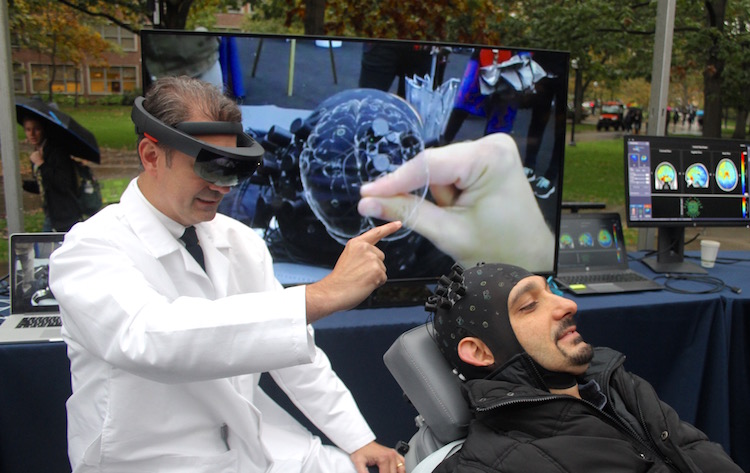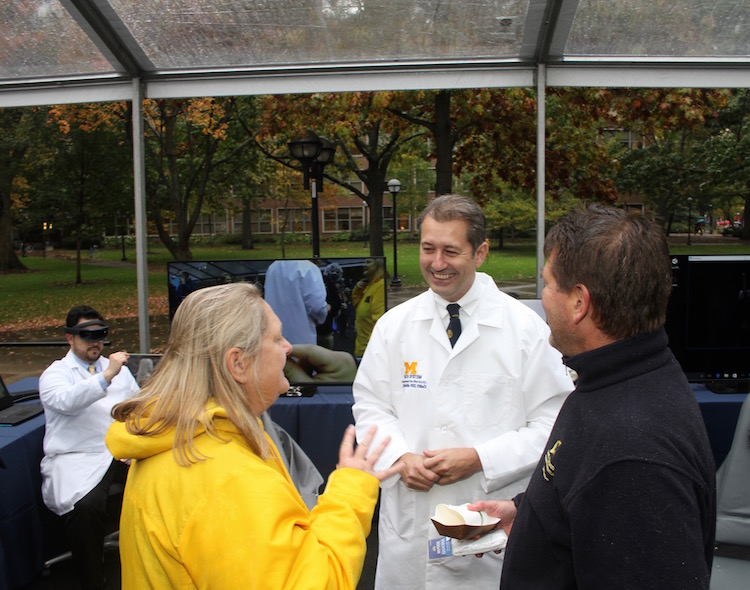H.O.P.E. Lab draws interest at Fall Festival expo4 min read
DaSilva lab demonstrates neuro-imaging techniques
Ann Arbor, Mich., Oct. 30, 2017 -– A School of Dentistry lab was among the University of Michigan research projects featured Friday during the Third Century Expo as part of the UMich200 Fall Festival.

Dr. Alexandre DaSilva’s Headache and Orofacial Pain Effort, or H.O.P.E. lab, presented a demonstration in one of several large tents set up along the Diag and Ingalls Mall as part of the university’s Bicentennial celebration. The public fair on Homecoming weekend drew several thousand spectators who braved a rainy afternoon and evening to see a variety of cutting-edge projects and initiatives that demonstrate how the university is making a positive impact on society, both locally and globally.
DaSilva, associate professor in the Department of Biologic and Materials Sciences, and his researchers use a variety of neuro-imaging techniques, including 3D software and equipment, to examine pain centers in the brain in a clinical environment. They have adapted Microsoft HoloLens technology similar to video gaming equipment that uses 3-D goggles. Sensors placed on a subject’s head send information wirelessly to the HoloLens, which shows color-coded areas of brain activation in real-time. The augmented reality superimposes holograms over the real world, which in this research is the subject’s brain.

Hassan Jassar, a research scientist in the lab, was the center of attention at the demonstration as he reclined in a dental chair wearing a black skullcap with a cluster of sensors protruding from it. DaSilva and research investigators Thiago Nascimento and Frank Hu took turns wearing the 3-D goggles to manipulate brain images that were projected onto a large video monitor for the audience to see. Diana Burnett, the lab’s clinical research coordinator, and the rest of the team fielded questions from the steady stream of visitors who stopped to watch the demonstration.
The brain-imaging technique uses functional near infrared spectroscopy, or fNIRS, to document changes in the brain when patients perform various mental tasks or experience pain. The fNIRS method monitors regional cerebral blood flow variations by measuring, through the skull, the absorption changes of near-infrared light at specific wavelengths.
The research investigates novel therapeutic approaches to alleviate chronic pain disorders, including migraines, head and neck cancer pain temporomandibular disorders or other pain associated with the orofacial complex. Researchers are documenting how patients’ brains react when they are exposed to a dental pain stimulation in a clinical setting. This research is valuable for patients who suffer various types of ongoing pain. It also may help explain long-term affects after patients have experienced traumatic pain during dental procedures.

H.O.P.E. lab is a multidisciplinary collaborative effort at the School of Dentistry between the Biologic and Materials Sciences Department, the Center for Human Growth and Development, the UM3D Lab and the Molecular and Behavioral Neuroscience Institute at the Medical School. The lab is developing a conceptual pain clinic called M-CARP, or Michigan Clinical Augmented Reality Pain unit at the Center for Human Growth and Development.
###
The University of Michigan School of Dentistry is one of the nation’s leading dental schools engaged in oral health care education, research, patient care and community service. General dental care clinics and specialty clinics providing advanced treatment enable the school to offer dental services and programs to patients throughout Michigan. Classroom and clinic instruction prepare future dentists, dental specialists, and dental hygienists for practice in private offices, hospitals, academia and public agencies. Research seeks to discover and apply new knowledge that can help patients worldwide. For more information about the School of Dentistry, visit us on the Web at: www.dent.umich.edu.
Contact: Lynn Monson, associate director of communications, at [email protected], or (734) 615-1971.
